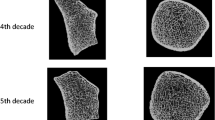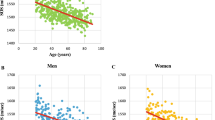Abstract
Summary
A reference database for trabecular bone density, cortical thickness, and elastic modulus of trabecular bone for a novel ultrasonic bone densitometry system (LD-100) based on two longitudinal waves (fast and slow) was determined over a wide age range in a normal Japanese population.
Introduction
A novel ultrasonic bone densitometry system (LD-100 system) was applied to create a reference database for trabecular bone density (TBD), cortical thickness (CoTh), and elastic modulus of trabecular bone (EMTb) for this device over a wide age range in a normal Japanese population.
Methods
In a comparative study between LD-100 and peripheral quantitative computed tomography (pQCT) systems, 52 individuals were examined by both systems at the same radius simultaneously. To create a reference database, a total of 2,380 healthy subjects (1,179 men, 1,201 women), ages 18–99 years, were examined using the LD-100 system.
Results
Highly significant correlations between the LD-100 and pQCT systems were found in TBD (r = 0.877, p < 0.001) and CoTh (r = 0.723, p < 0.001). For the reference database, peak values of TBD, CoTh, and EMTb were observed at 30–34 years (255.09 mg/cm3), 20–24 years (5.23 mm), and 20–24 years (4.09 GPa) in men, and at 25–29 years (209.24 mg/cm3), 25–29 years (3.98 mm), and 20–24 years (3.33 GPa) in women, respectively. The TBD fell significantly (p < 0.05) beginning at 55–59 years in both sexes, with a relatively rapid decrease in women. The CoTh showed a significant decrease beginning at 40–44 years in men and 50–54 years in women. The EMTb showed a significant decrease beginning at 40–44 years in men and 55–59 years in women.
Conclusions
The LD-100 system is a useful bone densitometry device and the database of age-related changes in TBD, CoTh, and EMTb established in this study will provide fundamental data for future studies related to bone status.



Similar content being viewed by others
References
Beck TJ, Ruff CB, Mourtada FA, Shaffer RA, Maxwell-Williams K, Kao GL, Sartoris DJ, Brodine S (1996) Dual-energy X-ray absorptiometry derived structural geometry for stress fracture prediction in male US Marine Corps recruits. J Bone Miner Res 11:645–653
Marshall D, Johnell O, Wedel H (1996) Meta-analysis of how well measures of bone mineral density predict occurrence of osteoporotic fractures. BMJ 312:1254–1259
Cummings SR, Bates D, Black DM (2002) Clinical use of bone densitometry: scientific review. JAMA 288:1889–1897
Engelke K, Adams JE, Armbrecht G, Augat P, Bogado CE, Bouxsein ML, Felsenberg D, Ito M, Prevrhal S, Hans DB, Lewiecki EM (2008) Clinical use of quantitative computed tomography and peripheral quantitative computed tomography in the management of osteoporosis in adults: the 2007 ISCD Official Positions. J Clin Densitom 11:123–162
Engelke K, Libanati C, Liu Y, Wang H, Austin M, Fuerst T, Stampa B, Timm W, Genant HK (2009) Quantitative computed tomography (QCT) of the forearm using general purpose spiral whole-body CT scanners: accuracy, precision and comparison with dual-energy X-ray absorptiometry (DXA). Bone 45:110–118
Genant HK, Engelke K, Fuerst T, Gluer CC, Grampp S, Harris ST, Jergas M, Lang T, Lu Y, Majumdar S, Mathur A, Takada M (1996) Noninvasive assessment of bone mineral and structure: state of the art. J Bone Miner Res 11:707–730
Gluer CC (1997) Quantitative ultrasound techniques for the assessment of osteoporosis: expert agreement on current status. The International Quantitative Ultrasound Consensus Group. J Bone Miner Res 12:1280–1288
Pocock NA (1998) Quantitative diagnostic methods in osteoporosis: a review. Australas Radiol 42:327–334
Njeh CF, Fuerst T, Diessel E, Genant HK (2001) Is quantitative ultrasound dependent on bone structure? A reflection. Osteoporos Int 12:1–15
Krieg MA, Barkmann R, Gonnelli S, Stewart A, Bauer DC, Barquero LDR, Kaufman JJ, Lorenc R, Miller PD, Olszynski WP, Poiana C, Schott AM, Lewiecki EM, Hans D (2008) Quantitative ultrasound in the management of osteoporosis: the 2007 ISCD Official Positions. J Clin Densitom 11:163–187
Njeh CF, Saeed I, Grigorian M, Kendler DL, Fan B, Shepherd J, McClung M, Drake WM, Genant HK (2001) Assessment of bone status using speed of sound at multiple anatomical sites. Ultrasound Med Biol 27:1337–1345
Hosokawa A, Otani T (1997) Ultrasonic wave propagation in bovine cancellous bone. J Acoust Soc Am 101:558–562
Hosokawa A, Otani T, Suzaki T, Kubo Y, Takai S (1997) Influence of trabecular structure on ultrasonic wave propagation in bovine cancellous bone. Jpn J Appl Phys 44:3233–3237
Hosokawa A, Otani T (1998) Acoustic anisotropy in bovine cancellous bone. J Acoust Soc Am 103:2718–2722
Hughes ER, Leighton TG, Petley GW, White PR (1999) Ultrasonic propagation in cancellous bone: a new stratified model. Ultrasound Med Biol 25:811–821
Fellah ZE, Chapelon JY, Berger S, Lauriks W, Depollier C (2004) Ultrasonic wave propagation in human cancellous bone: application of Biot theory. J Acoust Soc Am 116:61–73
Lee KI, Yoon SW (2006) Comparison of acoustic characteristics predicted by Biot's theory and the modified Biot-Attenborough model in cancellous bone. J Biomech 39:364–368
Marutyan KR, Holland MR, Miller JG (2006) Anomalous negative dispersion in bone can result from the interference of fast and slow waves. J Acoust Soc Am 120:EL55–EL61
Laugier P, Talmant M, Pham TL (2008) Quo vadis, ultrasonics of bone? present state and future trends. Arch Acoust 33:553–564
Otani T (2005) Quantitative estimation of bone density and bone quality using acoustic parameters of cancellous bone for fast and slow waves. Jpn J Appl Phys 44:4578–4582
Mano I, Horii K, Takai S, Suzaki T, Nagaoka H, Otani T (2006) Development of novel ultrasonic bone densitometry using acoustic parameters of cancellous bone for fast and slow waves. Jpn J Appl Phys 45:4700–4702
Mano I, Yamamoto T, Hagino H, Teshima R, Takada M, Tsujimoto T, Otani T (2007) Ultrasonic transmission characteristics of in vitro human cancellous bone. Jpn J Appl Phys 46:4858–4861
Yamamoto T, Otani T, Hagino H, Katagiri H, Okano T, Mano I, Teshima R (2009) Measurement of human trabecular bone by novel ultrasonic bone densitometry based on fast and slow waves. Osteoporos Int 20:1215–1224
Otani T, Mano I, Tsujimoto T, Yamamoto T, Teshima R, Naka H (2009) Estimation of in vivo cancellous bone elasticity. Jpn J Appl Phys 48:1–5
Augat P, Fuerst T, Genant HK (1998) Quantitative bone mineral assessment at the forearm: a review. Osteoporos Int 8:299–310
WHO (1994) Assessment of fracture risk and its application to screening for postmenopausal osteoporosis. Report of a WHO Study Group. World Health Organ Tech Rep Ser 843:1–129
Jamal SA, Gilbert J, Gordon C, Bauer DC (2006) Cortical pQCT measures are associated with fractures in dialysis patients. J Bone Miner Res 21:543–548
Gorai I, Nonaka K, Kishimoto H, Sakata H, Fujii Y, Fujita T (2001) Cut-off values determined for vertebral fracture by peripheral quantitative computed tomography in Japanese women. Osteoporos Int 12:741–748
Gatti D, Sartori E, Braga V, Corallo F, Rossini M, Adami S (2001) Radial bending breaking resistance derived by densitometric evaluation predicts femoral neck fracture. Osteoporos Int 12:864–869
Louis O, Boulpaep F, Willnecker J, Van den Winkel P, Osteaux M (1995) Cortical mineral content of the radius assessed by peripheral QCT predicts compressive strength on biomechanical testing. Bone 16:375–379
Wahner HW, Eastell R, Riggs BL (1985) Bone mineral density of the radius: where do we stand? J Nucl Med 26:1339–1341
Pacifici R (2008) Postmenopausal osteoporosis: how the hormonal changes of menopause cause bone loss. In:Marcus.R ,Feldman.D, Nelson.D, Rosen, C (eds). Osteoporosis, 3rd edn, vol 2. Elsevier Academic Press, Burlington, Massachusetts, USA, pp 1041–1054
Riggs BL, Khosla S, Melton LJ III (2008) Estrogen, bone homeostasis, and osteoporosis. In:Marcus.R,Feldman.D, Nelson.D, Rosen,C (eds). Osteoporosis, 3rd edn, vol 2. Elsevier Academic Press, Burlington, Massachusetts, USA, pp 1011–1039
Fujii Y, Miyauchi A, Takagi Y, Goto B, Fujita T (1995) Fixed ratio between radial cortical volume and density measured by peripheral quantitative computed tomography (pQCT) regardless of age and sex. Calcif Tissue Int 56:586–588
Kaji H, Kosaka R, Yamauchi M, Kuno K, Chihara K, Sugimoto T (2005) Effects of age, grip strength and smoking on forearm volumetric bone mineral density and bone geometry by peripheral quantitative computed tomography: comparisons between female and male. Endocr J 52:659–666
Yamauchi M, Sugimoto T, Chihara K (2004) Determinants of vertebral fragility: the participation of cortical bone factors. J Bone Miner Metab 22:79–85
Mizuno K, Matsukawa M, Otani T, Takada M, Mano I, Tsujimoto T (2008) Effects of structural anisotropy of cancellous bone on speed of ultrasonic fast waves in the bovine femur. IEEE Trans Ultrason Ferroelectr Freq Control 55:1480–1487
Kanis JA, Gluer CC (2000) An update on the diagnosis and assessment of osteoporosis with densitometry. Committee of Scientific Advisors, International Osteoporosis Foundation. Osteoporos Int 11:192–202
Faulkner KG, von Stetten E, Miller P (1999) Discordance in patient classification using T-scores. J Clin Densitom 2:343–350
Clowes JA, Peel NF, Eastell R (2006) Device-specific thresholds to diagnose osteoporosis at the proximal femur: an approach to interpreting peripheral bone measurements in clinical practice. Osteoporos Int 17:1293–1302
Hans D, Hartl F, Krieg MA (2003) Device-specific weighted T-score for two quantitative ultrasounds: operational propositions for the management of osteoporosis for 65 years and older women in Switzerland. Osteoporos Int 14:251–258
Kanterewicz E, Yanez A, Perez-Pons A, Codony I, Del Rio L, Diez-Perez A (2002) Association between Colles' fracture and low bone mass: age-based differences in postmenopausal women. Osteoporos Int 13:824–828
Cuddihy MT, Gabriel SE, Crowson CS, O'Fallon WM, Melton LJ 3rd (1999) Forearm fractures as predictors of subsequent osteoporotic fractures. Osteoporos Int 9:469–475
Schneider P, Reiners C, Cointry GR, Capozza RF, Ferretti JL (2001) Bone quality parameters of the distal radius as assessed by pQCT in normal and fractured women. Osteoporos Int 12:639–646
Szulc P, Delmas PD (2008) Biochemical markers of bone turnover in osteoporosis. In:Marcus R, Feldman D, Nelson D, and Rosen C (eds). Osteoporosis, 3rd edn, vol 2. Elsevier Academic Press, Burlington, Massachusetts, USA, pp 1519–1545
Acknowledgments
This work was supported by the Ministry of Education, Culture, Sports, Science, and Technology, Japan. We are grateful to Mrs. Takako Shirakawa and Mrs. Hiroko Iekura for their technical assistance. We also wish to express our gratitude to Ninindoshinkai Higashinada Community General Support Center and Wakinohama Koureisya Kaigoshien Center for their invaluable support.
Conflicts of interest
None.
Author information
Authors and Affiliations
Corresponding author
Rights and permissions
About this article
Cite this article
Sai, H., Iguchi, G., Tobimatsu, T. et al. Novel ultrasonic bone densitometry based on two longitudinal waves: significant correlation with pQCT measurement values and age-related changes in trabecular bone density, cortical thickness, and elastic modulus of trabecular bone in a normal Japanese population. Osteoporos Int 21, 1781–1790 (2010). https://doi.org/10.1007/s00198-010-1217-2
Received:
Accepted:
Published:
Issue Date:
DOI: https://doi.org/10.1007/s00198-010-1217-2




